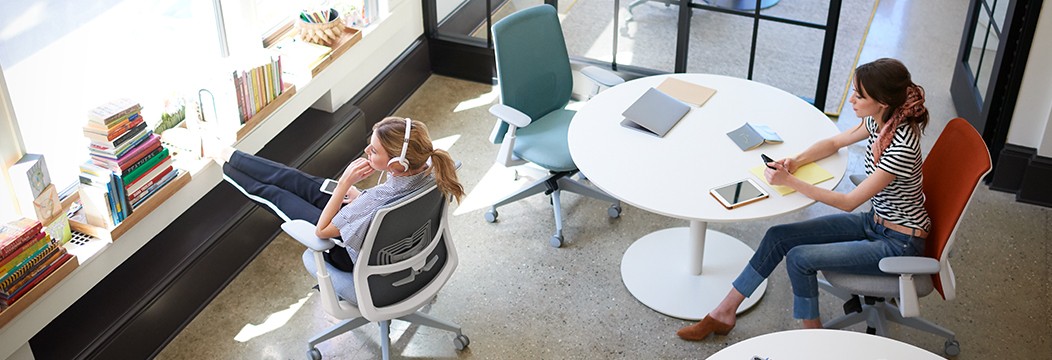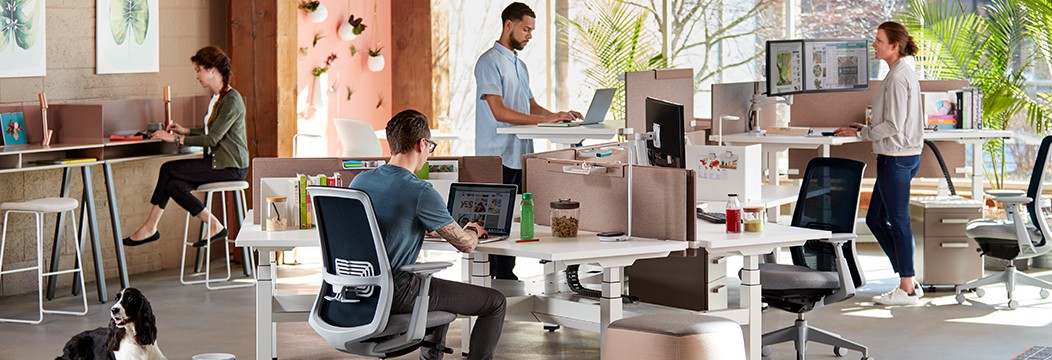Design a Happier Workplace
5 key design features that drive employee happiness
by haworth, inc. | june 1, 2018
These days, the office is less a tool for increasing productivity and more about making employee well-being a priority.
This shift is partly due to Millennials who blend their work and personal life. They come to work with the need for belonging, connection, and contribution to a greater good. This change in workplace expectations led the Haworth Research team to ask: Could office design become a driver of happiness and meaningful work?
The team’s findings show that a person’s workspace does affect happiness in two key ways. First, thoughtful workplace design gives people more control at work. Second, organizations that invest in flexible interiors where people are empowered to work the way they want demonstrate that they care about their people. This investment makes employees feel valued and contributes to their happiness.
5 design features that make employees feel valued
When the Haworth Research team reached out to 2,000 office workers across the US and beyond, they discovered five features that influence the ability to focus and increase the feeling of being valued—which increases employee happiness. They are:
- “Legibility” of the space – this means the ability to see and find others, understand the layout of the space, and the degree to which workspaces and furnishing convey their intended use
- Access to daylight
- User control to adjust the primary workspace
- Having the right technology in the individual workspace
- Adequate storage

Legibility and access to daylight have the largest impact on feeling valued. This makes sense because these two features are part of the overall ambient work environment. They affect everyone, regardless of the location or type of space used.
The other features that contribute to feeling valued—adjustability, technology, and storage—are experienced primarily, but not exclusively, within the individual workspace.
5 simple legibility design elements
“Cube farms” that are laid out with monotonous regularity create a disorienting maze and have costly negative consequences because they:
- suppress desirable movement of workers between workspaces
- increase wasted time
- reduce people’s sense of control
On the other hand, legible floorplans are easy to navigate. They make it easy for people to create a “mental map” of the layout. The layout sets up a predictable rhythm that makes it easy for them to learn or easily guess how to navigate the space. Using design cues, they can find any location in the building.

To create a legible floorplan, incorporate these five elements:
- Landmarks outside and inside the facility can serve as physical cues about locations within the building. For example, a building or a prominent feature that can be seen through windows may be an exterior landmark. Significant interior features such a café or a wall with a contrasting color or artwork can also act as landmarks.
- Plan configuration of the space can affect ease of understanding space layout. Highly irregular layouts can be confusing and have too many decision-points (path intersections) within the space.
- Visual access allows people to see ahead to landmarks or other areas for navigation. Having workstations with low horizons and avoiding architectural elements that block visual access to the building core can help open the space. Visual access outside the space through windows gives people sight lines for orientation as they move through the space.
- Architectural differentiation is the design of different areas to be visually distinct. These areas can serve as secondary landmarks. Differentiation can be as simple as a unified color scheme that identifies a department or a similar look and feel of a large area.
- Signage and graphics can provide information about the location and intended use of spaces, including directions to common areas or behavioral expectations.
Use design to make employees feel valued and provide legible workspaces. You’ll make workers happier by satisfying their need to connect and contribute to a greater good—and you’ll help create more productive organizations.
We’re just going to come out and say it: we’re named Cultura for a reason.
We create places so that you can #LOVEWHEREYOUWORK!
What do you think?
Let's chat!
WANT MORE?
Download Workplace Design and the Pursuit of Happiness and learn how happiness and meaningful work lead to more engaged, higher-performing, and healthier employees.
DOWNLOAD
